When Mark O’Connell began to work on his new book, “Notes From an Apocalypse,” four years ago, he was already thinking hard about the end times. “I was obsessed with the future, an obsession that manifested as an inability to conceive of there being any kind of future at all,” he writes. “Personal, professional and political anxieties had coalesced into a consuming apprehension of imminent catastrophe.” Widening inequality, surging nationalism, burning forests, melting ice caps: He describes an overwhelming sense of foreboding, the fear that whatever civilizational edifice has been erected was on the verge of total collapse.
O’Connell’s timing was either a bit premature or just right. In the last three months a global pandemic has already killed tens of thousands, disrupted fragile supply chains and laid bare which governments will quickly mobilize to save lives and which governments won’t. What was once considered a doomsday scenario is beginning to look like an actual situation.
But “Notes From an Apocalypse” isn’t meant to be a response to any particular event; it’s an exploration of a sensibility. O’Connell says his book was motivated by his own “tendency toward the eschatological.” He knows that this inclination is very old; upheaval and uncertainty have always given rise to cataclysmic thoughts. Increased access to information hasn’t abated the suspicion that something is going awry — if anything, we’re more informed than ever about the many forces that could do us in. “What if now it’s especially the end of the world,” O’Connell writes, “by which I mean even more the end of the world?”
He sets out to make a series of “perverse pilgrimages” to places where the end “could be glimpsed.” He doesn’t mean war zones or refugee camps or the rubbled landscape left behind by a hurricane. With the exception of the Chernobyl Exclusion Zone in Ukraine, where O’Connell joins a group tour navigating the remains of the 1986 meltdown, the destinations in this book are like the opposite of disaster areas — places where people gather to talk about the future or might go to escape whatever they fear might happen next.

O’Connell travels from his home in Dublin to South Dakota to meet a purveyor of tricked-out bunkers, in which well-heeled survivors can live out the rest of their days with access to a DNA vault and an 18-hole golf course. A journey to a wilderness reserve in the Scottish Highlands affords him a chance to commune with nature and minutely describe his fear of ticks. He meets aspiring space colonists at a conference of the Mars Society in Los Angeles. He takes a dip in New Zealand’s Lake Wanaka, gulping down the pristine fresh water that the tech billionaire Peter Thiel — who obtained New Zealand citizenship in 2011 and bought property there — intends to enjoy once the apocalypse (or revolution) comes.
Some of the stops on this travelogue are so spectacularly scenic that I found myself envious, and not a little bit suspicious: Here was someone who had figured out a way to tour the world by writing about the end of it. O’Connell admits that as a white man living a comfortably bourgeois existence — a homeowner, married with children — he’s wrapped in a “complex fabric of guilt and self-contempt.” He flies to far-flung idylls, expanding his carbon footprint to reach them. “It would have been healthier, of course, not to mention more useful, to attempt to effect some small good in the world,” he writes, “but this did not seem to be how I was wired.”
What he offers instead is a funny, self-deprecating inquiry into his own complicity. His therapist makes an intermittent appearance; at one session, O’Connell starts telling her about internet memes and ends up talking about the psychologist Steven Pinker’s hair. He reads his young son the Dr. Seuss story of the Lorax, a gentle creature who presides over a landscape that’s been stripped bare for the rampant production of consumer items called Thneeds. O’Connell wonders what his own Thneeds are, and the human cost of what it takes to make them. He ruefully imagines the people who harvested the beans for his coffee, and the factory workers “who made the smartphone on which I listened to leftist political podcasts as I walked, drinking the flat white.”
A number of preppers he meets and reads about tend to have oodles of money, or else have found a way to cater to those who do. While the 99 percent may have started hoarding beans and toilet paper, the truly rich have long been hoarding other, vastly more expensive and valuable resources: passports, property, private security, proximity to clean air and fresh water.
These End Times Ultras seem unbothered by civilizational collapse, O’Connell writes, “as long as they could carry on creating wealth” for themselves. It’s hard to imagine exactly how they’ll do that post-society, without any people to serve as the laborers and consumers who helped them create wealth in the first place. But a consistent worldview isn’t the point. The prepper and the journalist who flies halfway around the world to write about him are responding to the same stimulus. “Both,” O’Connell says, “are looking for ways to negotiate their terror.”
Citing the cultural critic Sarah Sharma, O’Connell says that there’s something “fundamentally male” in these narratives of escape — a fantasy of the autonomous patriarch who gets to withdraw from the world instead of reckon with it. Sharma contrasts this with the ethic of care, which faces the facts of contingency and dependency by trying to cultivate solidarity and sustenance. While O’Connell was negotiating his terror, he says, his wife asked him to pay attention to the world as it is: “This was a house, and people were trying to live in it.”
 EU News Digest Latest News & Updates
EU News Digest Latest News & Updates



